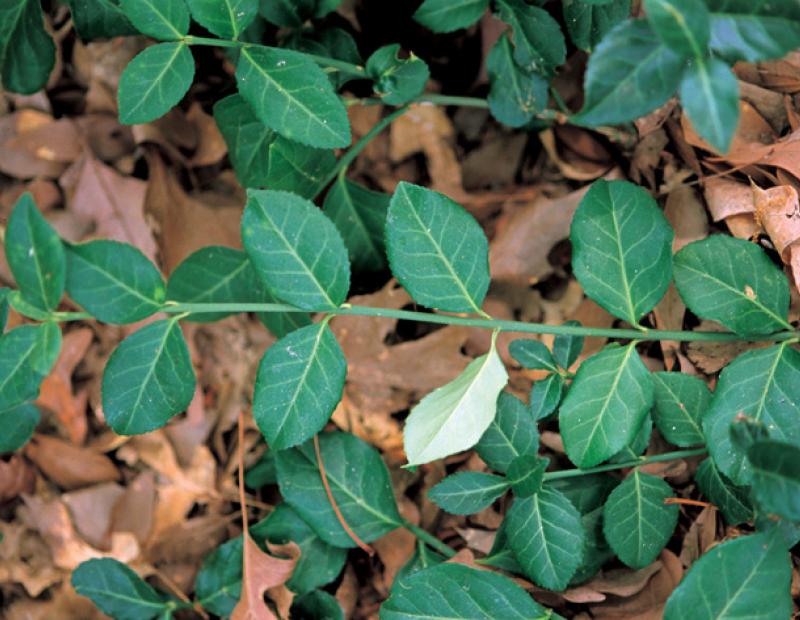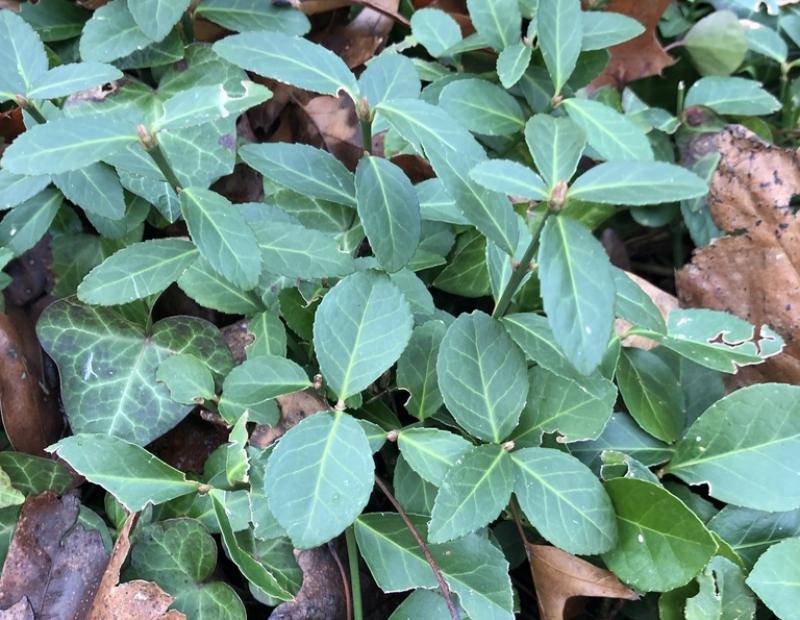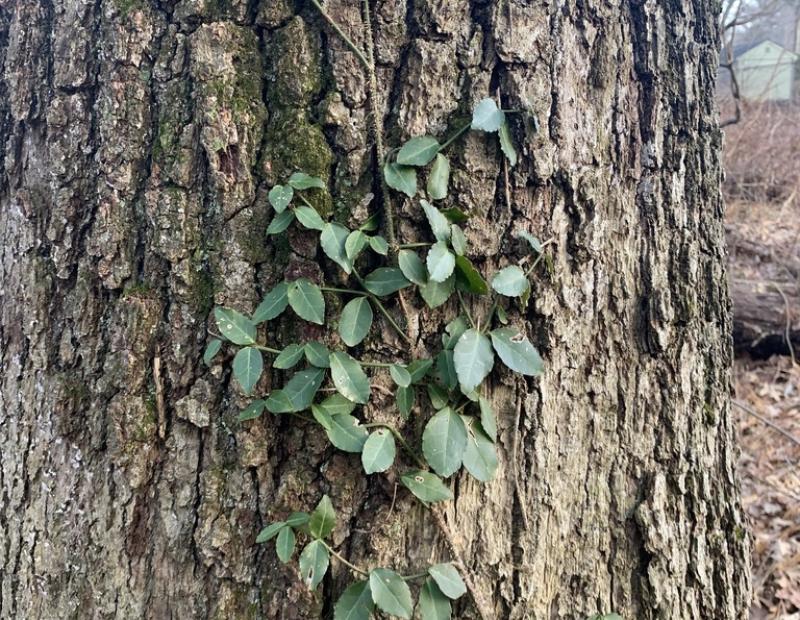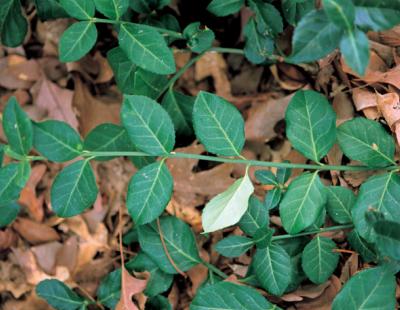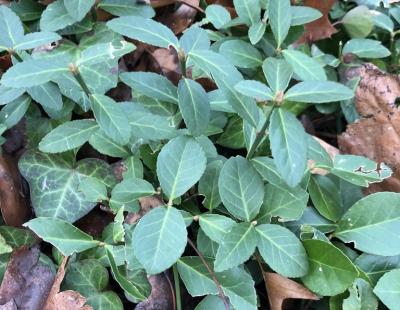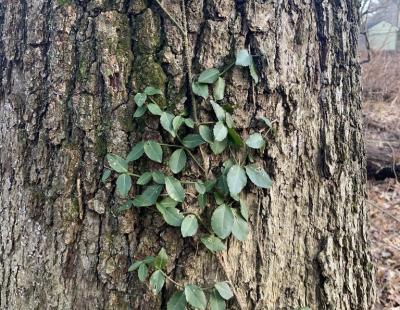Vertical Tabs
Winter creeper is a member of the Bittersweet family (Celastraceae). It is an evergreen vine and can also assume the form of a small shrub. Stems are narrow and covered in rooting nodes which make the plant ‘warty’ in appearance. Most conspicuous in winter, the glossy leaves of this sprawling vine remain dark green and generally attached to the plant throughout the year. It may be possible to confuse winter creeper with native members of the same genus, although these species are not common in New York. Strawberry bush (Euonymus americanus) is somewhat sprawling when young, but matures into an upright, deciduous bush. Furthermore, this native species’ flowers and fruits are five-parted, as opposed to winter creeper’s four-parted flowers and fruits. Running strawberry bush (Euonymus obovatus), as the name suggests, may assume a vine form or mature into a small upright shrub; however, this native has five parted flowers and fruits unlike the four sections of winter creeper.
Winter creeper is tolerant of both full sun and full shade, and capable of adapting to a variety of soil conditions. Due to its rapid vegetative growth, this species can quickly cover large areas, outcompeting understory competition, and smothering trees and shrubs. (2) This perennial groundcover also alters soil nutrients and microbiota, driving ecosystem change and paving the way for further invasion.
Biological Control
No biological control option is currently available.
Manual or Mechanical Control
Pulling / Digging Up: Hand pulling or digging small seedlings or plants is possible, but care must be taken to remove all the root. Winter creeper has a tendency to re-sprout. (8)
Mowing: Mowing or weed whacking can prevent plants from climbing and flowering. This control method will not eradicate infestations. (8)
Girdling: Not applicable
Prescribed Fire: Low to moderate burns only top kill winter creeper. (2)
Torching: Torching is effective on small populations or in areas where winter creeper has been treated with herbicide and re-sprouting is occurring. (2)
Prescribed Grazing: Although winter creeper is palatable to a number of wildlife species, including deer and rabbits, herbivory rarely results in plant mortality. (7)
Soil Tilling: Not advisable. Winter creeper strongly re-sprouts from the root crown or root fragments when disturbed. (9)
Mulching: Some community groups report success at killing small populations of winter creeper with two years of thick cardboard mulching. (9)
Solarization: No information available
Hot Foam Spray: No information available
Chemical Control
The pesticide application rates and usage herein are recommendations based on research and interviews with land managers. When considering the use of pesticides, it is your responsibility to fully understand the laws, regulations and best practices required to apply pesticides in a responsible manner. At times, the pest you seek to treat may not be on a pesticide label, requiring a 2ee exemption from NYSDEC. Always thoroughly read the label of any pesticide and consult the NYSDEC or a licensed pesticide applicator with questions.
Foliar Spray: Foliar spray is very successful when used in combination with mowing or weed whacking. Weed whack plants to cut the leaves’ waxy cuticle and immediately apply a 2% solution of glyphosate or triclopyr during the growing season. (8)
Cut Stump: Larger stems can be effectively controlled by cutting in spring and immediately applying a 20% solution of glyphosate or triclopyr. All treated plants should be monitored for re-sprouting in 2-3 weeks and in the following growing season. (8)
Basal Bark: Not applicable
Stem Injection: Not applicable
Pre-Emergent Spray: Not applicable
The pesticide application rates and usage herein are recommendations based on research and interviews with land managers. When considering the use of pesticides, it is your responsibility to fully understand the laws, regulations and best practices required to apply pesticides in a responsible manner. At times, the pest you seek to treat may not be listed on a pesticide label, requiring a 2(ee) exemption from NYSDEC. Always thoroughly read the label of any pesticide and consult the NYSDEC or a licensed pesticide applicator with questions.
REFERENCES
1. https://www.dec.ny.gov/docs/lands_forests_pdf/isprohibitedplants2.pdf
2. https://www.fs.fed.us/database/feis/plants/vine/euofor/all.html
3. https://www.cabi.org/isc/datasheet/23204
4. https://plants.usda.gov/core/profile?symbol=EUFO5
5. https://www.cabi.org/isc/abstract/20103099368
6. https://gobotany.newenglandwild.org/species/euonymus/fortunei/
7. https://www.nybg.org/files/scientists/rnaczi/Mistaken_Identity_Final.pdf
8. https://mdc.mo.gov/trees-plants/problem-plant-control/invasive-plants/wi...
9.http://mc-iris.org/uploads/4/1/1/8/4118817/wintercreeper_detailed_contro...

